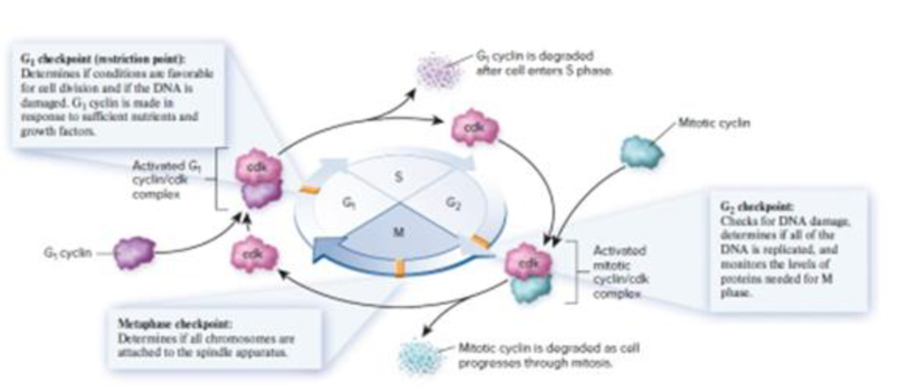
Core Skill: Modeling The goal of this modeling challenge is to predict the outcome of meiosis if one pair of chromosomes does not separate properly during meiosis II.
Modeling Challenge: In Figure 16.13, the starting cell in meiosis I has 3 homologous pairs of chromosomes that differ in length: short, medium, and long. Let’s suppose that during meiosis I, the segregation of the long chromosomes into the two daughter cells occurs abnormally, and both of the long chromosomes go into the same daughter cell. Draw a model showing the chromosomal composition of the four daughter cells at the end of meiosis II. For each pair of homologs, draw one red and the other blue, as in the figure. You do not need to include crossovers in your model.

Figure 16.3 Checkpoints in the cell cycle. This is a general diagram of the eukaryotic cell cycle. Advancement through the cell cycle requires the formation of activated cyclin/cdk complexes. Cells make different types of cyclin proteins, which are typically degraded after the cell has advanced to the next phase. The formation of activated cyclin/cdk complexes is regulated by checkpoint proteins.
Want to see the full answer?
Check out a sample textbook solution
Chapter 16 Solutions
Biology
- Need help with three question. Multiple choise. 1.) How is the outcome of meiosis different from the outcome of mitosis? a.) The daughter cells produced in mitosis are genetically different from the parent cells, but have the same number of chromosomes, while these are genetically similar in case of meiosis and have fewer chromosomes. b.) The daughter cells produced in mitosis are genetically similar to the parent cells and have the same number of chromosomes, while these are genetically different in meiosis and have half the number of chromosomes. c.) The daughter cells produced in both cases are genetically similar to the parent cells, but in meiosis, there are fewer chromosomes. d.) The daughter cells produced in both cases are genetically different, but in mitosis, there are fewwer chromosomes in daughter cells. 2.) What would be the effect on the number of chromosomes in gametes due to non-disjunction? a.) The chromosome number of the gametes remains the same as the parent…arrow_forwardNeed help with question: - if a nucleus has 12 chromosomes when it begins meiosis, how may chromosomes dose it have after telophase I ? How many are there after telophase II? - which meiotic phases underlie variation? - why is it advantageous for a species to have variation with in genetic material? When is it a disadvantage?arrow_forwardInquiry In a cross between a wild-type femalefruit fly and a mutant white-eyed male, what coloreyes will the F1 and F2 offspring have?arrow_forward
- HELP URGENTLY!!! NEED RESPONSE FAST Genes A, B and C are on the same chromosome linked in cis (coupling) conformation. A is 13 cM from B, and B is 28 cM from C. The distance between A and C is 41 cM. The coefficient of coincidence is 0.45 for a trihybrid test cross. How many individuals with the genotype aaBbcc do you expect to see among the offspring of the cross if 1000 offspring are obtained? Please show your calculations and round your answer off to the nearest whole number.arrow_forwardQ1. a. Manually, using a pencil, draw a cell in anaphase II from an organism in which 2n = 2 and each chromosome is metacentric. b. Given that each G1 nucleus from this organism contains 16 picograms of DNA, how many picograms of chromosomal DNA would you expect in the cell shown here?arrow_forwardMAKE CONNECTIONS Look at Figure 12.7 and imagine the twodaughter cells undergoing another round of mitosis, yielding four cells.Compare the number of chromosomes in each of those four cells, aftermitosis, with the number in each cell in Figure 13.8, after meiosis. Whatis it about the process of meiosis that accounts for this difference, eventhough meiosis also includes two cell divisions?arrow_forward
- 10. Compare the number and type of cells that result from meiosis vs. mitosis. 11. How do the genetic contents of cells resulting from mitosis and meiosis differ? 12. Comparing and Contrasting Describe a similarity and a difference between meiosis I and meiosis II. 13 Applying Concepts If a diploid cell containing 28 chromosomes undergoes meiosis, how many chromosomes will each daughter cell have? 14 Compare and Contrast: How are mitosis and meiosis similar and different?arrow_forwardNeed help Q1: Assuming these two genes sort independently, how many progeny would you expect to show the green striped phenotype? (Enter your answers as a whole number, e.g. 1) Q2: Which of the following are recombinant phenotypes? (Select all that apply) A. Green and Spotted B. Green and Striped C. Yellow and Spotted: D. Yellow and Stripedarrow_forwardURGENT PLZ HELP If you ignore the effect of crossing over, would you expect differences in the genetic information between a spermatid and the secondary spermatocyte from which it was derived? Explain your answer completely.arrow_forward
- Still studying meiosis. How many chromosomes does a haploid cell have? In prophase II how many chromosomes does each daughter cell have?arrow_forwardVISUALIZE Sketch a series of diagrams showing each of the following, making sure to end each series with haploid cells: (a)How a pair of alleles for a single locus segregate in meiosis (b)How the alleles of two unlinked loci assort independently in meiosis (c)How the alleles of two linked loci undergo genetic recombinationarrow_forwardVISUAL SKILLS In this diagram, does the sperm cell that fertilizes the egg cell differ geneticallyfrom the egg? Explain.arrow_forward
 Biology (MindTap Course List)BiologyISBN:9781337392938Author:Eldra Solomon, Charles Martin, Diana W. Martin, Linda R. BergPublisher:Cengage Learning
Biology (MindTap Course List)BiologyISBN:9781337392938Author:Eldra Solomon, Charles Martin, Diana W. Martin, Linda R. BergPublisher:Cengage Learning Biology: The Dynamic Science (MindTap Course List)BiologyISBN:9781305389892Author:Peter J. Russell, Paul E. Hertz, Beverly McMillanPublisher:Cengage Learning
Biology: The Dynamic Science (MindTap Course List)BiologyISBN:9781305389892Author:Peter J. Russell, Paul E. Hertz, Beverly McMillanPublisher:Cengage Learning

